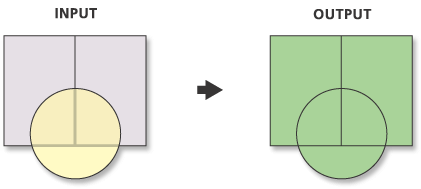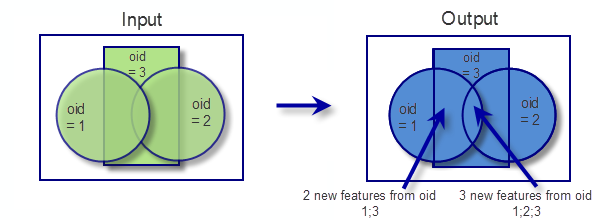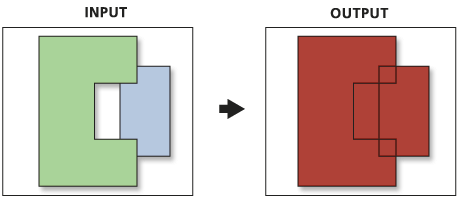- Home
- :
- All Communities
- :
- Products
- :
- Geoprocessing
- :
- Geoprocessing Questions
- :
- Re: U.S. protected areas and U.S. counties
- Subscribe to RSS Feed
- Mark Topic as New
- Mark Topic as Read
- Float this Topic for Current User
- Bookmark
- Subscribe
- Mute
- Printer Friendly Page
U.S. protected areas and U.S. counties
- Mark as New
- Bookmark
- Subscribe
- Mute
- Subscribe to RSS Feed
- Permalink
Hi,
I am doing research in endangered species and land management. I am very new to ArcGIS.
I have this U.S. protected areas geodatabase which has the information of each U.S. protected area, including state (but not county), type, acreage, etc. I also the U.S. county map. Now I would like to figure out in which county each of the protected areas is located so that I can do some analysis on the county-level data. Could anybody kindly teach me how to do this? I'd appreciate the help!
Jane
- Mark as New
- Bookmark
- Subscribe
- Mute
- Subscribe to RSS Feed
- Permalink
What you are describing is the a common GIS procedure. For the the analysis, there are a variety of methods available at your disposal that depending on your research question and the data available.
Do the protected areas have a shape component?
Do they draw in ArcMap or are they just a table?
Are you summarizing the (dissolving) the protected areas by county?
You would do well to review Overlay Analysis with tools such as intersect, selection and union. A Spatial Join would also work well to transfer attributes (county name) to your protected areas. You can search youtube for special tutorials as well.
Here is a link for summarizing points in other features
- Mark as New
- Bookmark
- Subscribe
- Mute
- Subscribe to RSS Feed
- Permalink
Hi Langdon,
Thank you very much for your reply. The protected areas database is in gdb
format. So I guess the answer to your first question is that it has a shape
component. And it was drawn in ArcMap.
The protected areas database has two attributes that are mostly useful to
us: the land management type of each area and the acreage of each area. So
what we would like to do eventually is to aggregate the acreage in
different management types to county level.
I just tried union and seems like it worked. However, there are something I
do not quite understand in the new attribute table that I opened from the
post-union file.
First, a new OBJECTID and two new FID fields are generated. This I figured
out. The two new FID fields are duplication from the OBJECTID fields of the
two original databases. However, in the post-union file there are some -1s
in the new FID filed for the protected areas data. I wonder if it means
some counties just don't have any protected areas. So -1 here represent
"null"?
Second, many of the protected areas appear multiple times with different
county names in the post-onion file. Does it mean that each of the areas
covers more than one county? If so, is there a way to calculate the acreage
of a certain protected in each county?
Xiaoou
2014-12-11 16:46 GMT-08:00 Langdon Sanders <geonet@esri.com>:
U.S. protected areas and U.S. counties
reply from Langdon Sanders
<http://jiveon.jivesoftware.com/wf/click?upn=Dg1s4x8le7Lmxv8KWGaqo7A4BXwO9PY1WvQ5cXCtK49SE6CgBhkqdCl5jXWeF6BfisCUhelAv9sZBQC2Ct6Hp1rbv20hnthJI38OrE7fL7U-3D_xvy4qIJyhUdGfVHy7TMOxkcWnYc-2F-2FBtsZLAnBLW9qzrGpunfcw5r-2Fy4tn4jZV8kma8CcmJvxtXmJxFaKbzoUu87m75BFJB3mBPyiVgbw-2BYBP9FfR3pIyVoI36OlVDfTKUljhTaRdz8BZlkoaf3SOpvaSpLIAZBFrdCLKeXj4j1s7-2FHS7aKT-2BvkOdp8mT8xILS1J5k1rWNuUAME7VHQ3dPwxurYW9ecKQX8vJgKlp15YDzJ54sB-2BQKQ8Jgy-2BQGP97pmeT8nO004J1P-2F1Ey-2BbqtxrmEYIg-2BtaGF0EAQ9pcO4mM3smEnH8QTtgLS-2BYOoMnz>
in Xiaoou Han - View the full discussion
<http://jiveon.jivesoftware.com/wf/click?upn=Dg1s4x8le7Lmxv8KWGaqo0VQjeJBYpG9HGC8QZBT-2FEwbSgEjcAxJsWXJ-2FUD6AT5hr-2FnWp7tEtB-2BgrzbWsuKLQxtKkjOLpm9xiTz7BYf0MsE-3D_xvy4qIJyhUdGfVHy7TMOxkcWnYc-2F-2FBtsZLAnBLW9qzrGpunfcw5r-2Fy4tn4jZV8kma8CcmJvxtXmJxFaKbzoUu87m75BFJB3mBPyiVgbw-2BYBP9FfR3pIyVoI36OlVDfTKfI3mt6jLiuzUxzP-2BWt7A1amsCmB3iE-2BKRzGKI5sJ53gwRA-2BnTVLwdMjcvPRKIT4JEBNtOclRSNkqcjqLd3SCwBflteEVK4AkDnFJlbqEWraMZC-2BxfWO-2BWFyAbB7z6IJr8HITNnhCmyiqTxCUtrIXBSsRm2tC7SsXx-2F8-2Bf0s1bGrozCWCrfxb0ymumfvriDPs>
- Mark as New
- Bookmark
- Subscribe
- Mute
- Subscribe to RSS Feed
- Permalink
Hello Xiaoou,
SUMMARIZE
The protected areas database has two attributes that are mostly useful to
us: the land management type of each area and the acreage of each area. So
what we would like to do eventually is to aggregate the acreage in
different management types to county level.
To aggregate or summarize features based on a common category, such as land management type, county, region, etc, you will typically use the Dissolve function or to export just with stats use summarize. You will typically dissolve as the last step of the analysis at which point you can export the table to a csv or excel file for reports and graphing.
For the Union tool, you are correct in you understanding. The -1's will be non-matches where there was no corresponding intersection between the features and therefore no FID to attributes to bring over. This is in the tool documentation for Union under "Usage". Note that any tool in ArcMap you can click "tool help" as well for more details.
UNION
Second, many of the protected areas appear multiple times with different
county names in the post-onion file. Does it mean that each of the areas
covers more than one county?
If you take a look at the image it shows that features will be sliced on their crossing boundaries. You should inspect some examples of repeated land areas, but it is likely that one part of the land area is in County A and the other part(s) are in County B, C, etc.

CALULATE AREA
If so, is there a way to calculate the acreage
of a certain protected in each county?
First create a new field in your attribute table to hold acreage (type double will be fine). In the attribute table, you can right click a field and calculate values all records or selected records in that field. You can select Calculate Geometry and select US Acres from the drop down menu. The Field Calculator calculate algebraic equations and programming expressions based on other fields. Become very familiar with using the field calculator as it is a primary tool in GIS and data manipulation.
To summarize acreage by county, union the features, dissolve by county, state name (to avoid false positives), and land type, then calculate field in acres for resulting table.
- Mark as New
- Bookmark
- Subscribe
- Mute
- Subscribe to RSS Feed
- Permalink
Hi Langdon,
Thanks so much for your answer. This saves my life! Will follow your
suggestions and try to figure it out in ArcGIS.
Best,
Xiaoou
2014-12-12 6:13 GMT-08:00 Langdon Sanders <geonet@esri.com>:
U.S. protected areas and U.S. counties
reply from Langdon Sanders
<http://jiveon.jivesoftware.com/wf/click?upn=Dg1s4x8le7Lmxv8KWGaqo7A4BXwO9PY1WvQ5cXCtK49SE6CgBhkqdCl5jXWeF6BfisCUhelAv9sZBQC2Ct6Hp1rbv20hnthJI38OrE7fL7U-3D_xvy4qIJyhUdGfVHy7TMOxkcWnYc-2F-2FBtsZLAnBLW9qzrGpunfcw5r-2Fy4tn4jZV8kma8CcmJvxtXmJxFaKbzoUu87m75BFJB3mBPyiVgbw-2BYAzCsB9jCJsDCA0pCzJuyusrxUSP1XY1lfjr6Wz7V2aaAIBFHq2uoj8-2FoFwuRHW2PyHI-2FWZWQ6hSC1u1oe8r-2FyZ1L8YrdUTPWtdOyRogFq1DtJ4PuYBkPV7bgFSis8WLiIxtGZnbDrh3O9BB1ac-2Fq-2B-2Bg6-2Bxjv-2BLePxKdyUk1mUVqrSG-2FbocrCeesL9NfMRauc6MSbSpwMhhJO5sHwP3jM1q>
in Xiaoou Han - View the full discussion
<http://jiveon.jivesoftware.com/wf/click?upn=Dg1s4x8le7Lmxv8KWGaqo0VQjeJBYpG9HGC8QZBT-2FEw5-2FR-2BRqfVf4U5Gc-2FD-2FURVExo5Qkd51Zyank3F1FpEXqtsDvPgysmQH-2FExQuYs0B2g-3D_xvy4qIJyhUdGfVHy7TMOxkcWnYc-2F-2FBtsZLAnBLW9qzrGpunfcw5r-2Fy4tn4jZV8kma8CcmJvxtXmJxFaKbzoUu87m75BFJB3mBPyiVgbw-2BYAzCsB9jCJsDCA0pCzJuyusjV57s-2F2D9zWEwZboOd3pzeS18wy6YbA9ELZVMCt7VEJB-2BLBh1aM0FJDo-2B4QJTQchMY30l-2F-2BjM-2BArZ6tAL831B6jrfRKC-2BoRAJiT0vzBjZOw-2FRLAaff7d-2F8okX0AKIxzey73jbeYt8UjxHDG61Kp-2FM2Tr1vGSWO1qFc9qwAhYY7WWXQg9Tgd7zrzuaKWiNW-2BQ>
- Mark as New
- Bookmark
- Subscribe
- Mute
- Subscribe to RSS Feed
- Permalink
Hello Xiaoou,
I am happy to help. Please mark the question as answered if you have enough to go on for now. Thank you and good luck.
Langdon
- Mark as New
- Bookmark
- Subscribe
- Mute
- Subscribe to RSS Feed
- Permalink
Just did! Thanks.
Xiaoou
2014-12-12 9:32 GMT-08:00 Langdon Sanders <geonet@esri.com>:
U.S. protected areas and U.S. counties
reply from Langdon Sanders
<http://jiveon.jivesoftware.com/wf/click?upn=Dg1s4x8le7Lmxv8KWGaqo7A4BXwO9PY1WvQ5cXCtK49SE6CgBhkqdCl5jXWeF6BfisCUhelAv9sZBQC2Ct6Hp1rbv20hnthJI38OrE7fL7U-3D_xvy4qIJyhUdGfVHy7TMOxkcWnYc-2F-2FBtsZLAnBLW9qzrGpunfcw5r-2Fy4tn4jZV8kma8CcmJvxtXmJxFaKbzoUu87m75BFJB3mBPyiVgbw-2BYDbEEQGUuH3VZC6HLNvtjLM6J5zG9Dxyf5AybGnlgGo64rM7GXFkBxAxsu73ONKTVyelwwXj4gAzt-2FPDPwmz73gHtCLNIQlBnqlzqOR00V4fXEupFBa77SOwPlVP8o-2B5TKhWaRDaD2orI5-2FUFYvV6gTRPOs0BYmSZ1og8y7ThEcIpnH-2BzN8gW0725IG8zxOm4DznmCzZRpAMVg17EPWPICw>
in Xiaoou Han - View the full discussion
<http://jiveon.jivesoftware.com/wf/click?upn=Dg1s4x8le7Lmxv8KWGaqo0VQjeJBYpG9HGC8QZBT-2FEyl4Umw4y5a-2BMT9jUUqUz9whHq0li8Wl73aPE3R5EdFMsPXz-2BYn2ykDmk-2FDpqPKH8g-3D_xvy4qIJyhUdGfVHy7TMOxkcWnYc-2F-2FBtsZLAnBLW9qzrGpunfcw5r-2Fy4tn4jZV8kma8CcmJvxtXmJxFaKbzoUu87m75BFJB3mBPyiVgbw-2BYDbEEQGUuH3VZC6HLNvtjLM555hrShtkxMVBrNP2DczxOarLFpHZfW8n6AqkUAhGCXfB06ZtV-2FGvHiiEMpKEnrTzHlE3eQLX56dNCRAweX-2FDhksSv-2BFSdmWr5fOMJwUv1iAOm5PUTbHWPL4-2Bo-2FpspH44gPNG6pq6X-2FeVONq7s81fmjlLmBQxeocIAZbaRJbLyxJdTQvFHoTOyEOjG-2B7T9eD>
- Mark as New
- Bookmark
- Subscribe
- Mute
- Subscribe to RSS Feed
- Permalink
Hi Langdon,
I have a new question. I did Union the protected area database and an U.S.
county map which I downloaded from ArcGIS Online. Under the FID fileds of
each of the two parts, there are some -1. I understand that this means
there is no match. I see that it is possible that some counties do not have
any protected areas. However, I don't understand the other way around,
which is that a certain protected areas is not in any of the U.S. counties
indicated in the U.S. county map that I downloaded. I wonder if you have
any insight on why could this happen. Do you think it is possible that the
U.S. county map that I downloaded does not incorporate all of the counties
in the U.S.? It is quite updated though.
Thanks.
Xiaoou
2014-12-12 9:36 GMT-08:00 Xiaoou Han <xiaoou.han@gmail.com>:
Just did! Thanks.
Xiaoou
2014-12-12 9:32 GMT-08:00 Langdon Sanders <geonet@esri.com>:
>> U.S. protected areas and U.S. counties
>>
>> reply from Langdon Sanders
>> <http://jiveon.jivesoftware.com/wf/click?upn=Dg1s4x8le7Lmxv8KWGaqo7A4BXwO9PY1WvQ5cXCtK49SE6CgBhkqdCl5jXWeF6BfisCUhelAv9sZBQC2Ct6Hp1rbv20hnthJI38OrE7fL7U-3D_xvy4qIJyhUdGfVHy7TMOxkcWnYc-2F-2FBtsZLAnBLW9qzrGpunfcw5r-2Fy4tn4jZV8kma8CcmJvxtXmJxFaKbzoUu87m75BFJB3mBPyiVgbw-2BYDbEEQGUuH3VZC6HLNvtjLM6J5zG9Dxyf5AybGnlgGo64rM7GXFkBxAxsu73ONKTVyelwwXj4gAzt-2FPDPwmz73gHtCLNIQlBnqlzqOR00V4fXEupFBa77SOwPlVP8o-2B5TKhWaRDaD2orI5-2FUFYvV6gTRPOs0BYmSZ1og8y7ThEcIpnH-2BzN8gW0725IG8zxOm4DznmCzZRpAMVg17EPWPICw>
>> in Xiaoou Han - View the full discussion
>> <http://jiveon.jivesoftware.com/wf/click?upn=Dg1s4x8le7Lmxv8KWGaqo0VQjeJBYpG9HGC8QZBT-2FEyl4Umw4y5a-2BMT9jUUqUz9whHq0li8Wl73aPE3R5EdFMsPXz-2BYn2ykDmk-2FDpqPKH8g-3D_xvy4qIJyhUdGfVHy7TMOxkcWnYc-2F-2FBtsZLAnBLW9qzrGpunfcw5r-2Fy4tn4jZV8kma8CcmJvxtXmJxFaKbzoUu87m75BFJB3mBPyiVgbw-2BYDbEEQGUuH3VZC6HLNvtjLM555hrShtkxMVBrNP2DczxOarLFpHZfW8n6AqkUAhGCXfB06ZtV-2FGvHiiEMpKEnrTzHlE3eQLX56dNCRAweX-2FDhksSv-2BFSdmWr5fOMJwUv1iAOm5PUTbHWPL4-2Bo-2FpspH44gPNG6pq6X-2FeVONq7s81fmjlLmBQxeocIAZbaRJbLyxJdTQvFHoTOyEOjG-2B7T9eD>
>>
- Mark as New
- Bookmark
- Subscribe
- Mute
- Subscribe to RSS Feed
- Permalink
Hello Xiaoou,
I am happy to help,
What were the settings you used for this geoprocess? You can open the geoprocessing results window under the Window top menu. Click the session and double click the process to see what your settings were.
According to How Union Works the -1 can be due to gaps. Did you allow gaps in this process?
http://resources.arcgis.com/en/help/main/10.1/index.html#/How_Union_works/000800000010000000/
Below is an example of Union with features within a feature class that overlap. In this case, the area of overlap will be duplicated to maintain all the attributes and areas. To re-create the overlapping features, use the Dissolve tool on the feature class produced by Union, and dissolve by all fields except FID.
Below is an example of the result of executing Union with the Gaps Allowed parameter unchecked. A polygon feature is created that would otherwise be left empty. The "gap" features can be identified by doing an attribute query of all the input feature's FID fields that equal -1.
Intersect as an Option:
You could also use the Intersect tool instead. It would result in only the areas that are covered by both county land and protected land. Empty county area would not be included. The resulting land would in essence be the protected land, but with the county name attribute as well. You could then run a dissolve based on land type and county name & state to get totals for each county. To symbolize the USA map, join this dissolved results table back to your original county boundary data based on county name & state.
- Mark as New
- Bookmark
- Subscribe
- Mute
- Subscribe to RSS Feed
- Permalink
Yes, I think I did allow gaps by following what describe below.
The Allow Gaps parameter can be used with the ALL or ONLY_FID settings on
the Join Attribute parameter.
http://resources.arcgis.com/en/help/main/10.1/index.html#//000800000010000000
I chose the ALL setting on the Join Attribute parameter.
So does this mean that the -1 are gaps, which are non-matches?
Xiaoou
2014-12-16 16:58 GMT-08:00 Langdon Sanders <geonet@esri.com>:
U.S. protected areas and U.S. counties
reply from Langdon Sanders
<http://jiveon.jivesoftware.com/wf/click?upn=Dg1s4x8le7Lmxv8KWGaqo7A4BXwO9PY1WvQ5cXCtK49SE6CgBhkqdCl5jXWeF6BfisCUhelAv9sZBQC2Ct6Hp1rbv20hnthJI38OrE7fL7U-3D_xvy4qIJyhUdGfVHy7TMOxkcWnYc-2F-2FBtsZLAnBLW9qzrGpunfcw5r-2Fy4tn4jZV8kma8CcmJvxtXmJxFaKbzoUu87m75BFJB3mBPyiVgbw-2BYDwW7fNqk6HE5IkQcf-2B79wkQQIrU3IWscaYl8VCf7qUVG47wjGTGqosKZV2HaEb6V6usWEaUvsXLdsdaL9v36W-2FMFz7-2BWWsPCjPnSemezl0bCWiifAZB14XZ7P6lkqjAZT58wvXNHBzp5FRyQ2jeNbagoiAXU-2FSjVg90o25C5YU4Uxpkh8SU-2BoTM-2F3j2XTuPC8LLqOc0d6crloUCiENlbQM>
in Xiaoou Han - View the full discussion
<http://jiveon.jivesoftware.com/wf/click?upn=Dg1s4x8le7Lmxv8KWGaqo0VQjeJBYpG9HGC8QZBT-2FEyxQgVVHvr3lfrUieZFRC22GkHgxaDZtOdapMoEBFe3IN1kcddgUbAk5N3Zp56mNuE-3D_xvy4qIJyhUdGfVHy7TMOxkcWnYc-2F-2FBtsZLAnBLW9qzrGpunfcw5r-2Fy4tn4jZV8kma8CcmJvxtXmJxFaKbzoUu87m75BFJB3mBPyiVgbw-2BYDwW7fNqk6HE5IkQcf-2B79wkP1ON6L4YC8cgeqo2wYzq5nYzbOFanBwIzuWSEcH6gl6z5BPysHKSvHSGIBfk3PHdciWOKDtlnuv4pRqvtlyfprQgZg-2BlV73FoiwdMohkVkXa-2B-2B-2BuOJVTJ1bUjD-2BWqZQ4uthfItYLXx3ZqcmNiQDpaOTcb6lvaryXI7USJM8tsuP-2BQlZOd-2FcMHcRp9ffA6s45>

